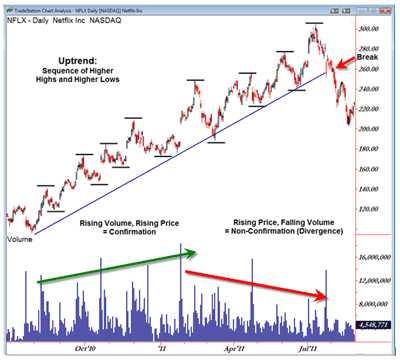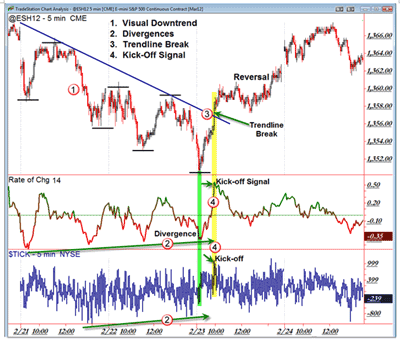Traders often search for reversal trade set-ups, which allow them to enter as close as possible to the elusive price top or bottom of a trend reversal. However, experience proves that entering at market tops or bottoms is not only very difficult, but can cost traders dearly as price continues marching forward in its established trend. Reversal strategies do have a place in a developing trader’s arsenal, but new traders often do better to adhere to less-risky strategies such as retracement set-ups that develop within a trend in motion, especially after a new trend has developed. When looking for trend reversals on any stock or ETF, follow these four steps before calling your next market top or bottom.
1. Mature or Lengthy Trend
There must be a trend in place to reverse. We classify trends as up, down, or sideways, and traders should not look for large-scale price reversals in the context of a sideways trading range or immediately after a new trend emerges. The first criterion to identify for reversal set-ups is the visual existence of a lengthy trend already in place. Trends are relative to the timeframe on which you trade, so an intraday trend could last as short as a few hours up to a few days, while a larger trend that is visible on the daily chart timeframe may last weeks or even months. Large-scale trends, the domain of position traders and investors, tend to last for years. Step one is to observe a visual trend on your particular timeframe depending on whether you are an intraday trader, swing trader, or position trader.
According to the definition of price trends, uptrends consist of a series of higher price highs along with higher price lows. Downtrends contain a series of visual lower price lows and lower price highs. Sideways trends appear as a series of relatively equal price highs and price lows which can often be bound with hand-drawn support and resistance trendlines.
Trend analysis can be as simple as drawing marks over price highs and lows and noting the sequence over time. Relative to the timeframe you are viewing, lengthy trends have a greater probability of reversing than new or shorter trends. Once you have identified a visual price trend on the chart, the next step is to assess the health of that trend.
2. Non-Confirmations and Divergences
Charles Dow explained the concept of confirmation or non-confirmation by comparing volume with price. Stated simply, price and volume should move together: price in a stable uptrend should be confirmed with stable increases in volume over time. Similarly, downtrends should generate higher volume as price continues declining. In the event volume and price diverge (move in opposite directions), this can be a signal of trend weakness and should call our attention to the possibility of a trend reversal in the future.
Today, we can broaden our perspective beyond volume to include momentum indicators such as the standard Rate of Change (RoC) and Breadth or market internal indicators. Market internal indicators help confirm or disconfirm short-term trends in market indexes such as the Dow Jones or S&P 500 and are helpful for intraday traders. Stock-specific traders will need to examine price relative to volume and momentum to spot non-confirmations or divergences. Divergences occur when price rises yet volume or a momentum indicator declines; specifically, non-confirmations occur when price pushes to higher highs yet indicators form lower highs. Once clear negative divergences or non-confirmations develop, we then look for confirming reversal signals from price itself.
CAPTION: Netflix (NFLX) demonstrates a mature uptrend (higher highs and higher lows) with volume divergences and a trendline breakdown reversal signal in August 2011.
3. Trendline or Price Breakdown
Our first step is to assess the existence of a trend and the second step is to assess the health of a trend, the third step is to look for actual price breakdowns of established trendlines or prior price levels. In the context of an uptrend, price gives a signal of early trend reversal when it breaks down under an established rising trendline or under a prior support swing low. While you can view this simply on a price chart, many traders prefer to use moving averages in the context of a trending move to show an indicator-based “trendline.” Traders often use a short-term moving average such as the 20-period average in conjunction with an intermediate- or longer-term moving average such as the 50-period average. Thus, in the context of an uptrend, price would confirm a reversal signal on the breakdown under both the short-term and intermediate-term moving average, which likely corresponds with a breakdown in a hand-drawn price trendline as well. This official price trigger is enough for aggressive traders to establish an early reversal position (placing a stop beyond the recent price high), but there’s one more factor to watch for final confirmation.
4. Kick-off Signal
The final step in a trend reversal is the presence of a “kick-off” or sudden increase in volume, momentum, or a market internal indicator during the trendline breakthrough. While we use these indicators to highlight divergences at the later stages of a mature trend, we also can use these same indicators to spot a confirmation signal as a new trend reverses in the opposite direction. Richard Wyckoff labeled this concept an initial “Sign of Strength” or “Sign of Weakness” to highlight a sudden impulse in the direction of a newly developing trend.
To spot a kick-off signal on your chart in the context of an new uptrend, look for a sudden spike to a new relative high in volume, a momentum oscillator, or market internal indicator when compared to the previous trend and prior indicator levels. Similarly, look for a spike higher in volume along with a new momentum or market internal indicator low in the context of a reversal to a new downtrend.
CAPTION: The @ES (S&P 500 E-mini futures March 2012 contract) completes the four-step reversal process from intraday downtrend to intraday uptrend on February 23, 2012. The Rate of Change (RoC) indicator along with NYSE TICK show divergences at the low and a sudden indicator impulse, or “kick-off” signal, as price breaks above the falling trendline.
Summary
To recap, look for price to complete these steps before assuming a trend has truly reversed. Speaking in terms of an uptrend reversing to a downtrend, look for the presence of a mature uptrend by noting the progression of swing highs and lows over time. If you have determined a lengthy price trend is present, then look for non-confirmations in volume, momentum, or market internals. A single divergence does not reverse a trend, and we need to wait for a trigger signal in price which develops in the form of a visual breakdown of hand-drawn rising price trendlines or under rising moving averages (such as the 20 and 50 period averages). Finally, as price breaks the trendline and moving average support, look for a confirming signal in the form of a “kick-off” or spike in volume, momentum, or market internals as price begins a fresh reversal.
Using this type of objective logic, you can then develop logical trades in the context of the early stages of a new trend reversal. Look to trade corresponding breakouts, and retracements as the new trend develops. When playing an aggressive reversal set-up, the ideal entry triggers on the breakdown under trendline or price support (particularly if the breakout also develops an indicator “kick-off”) as you place a stop-loss above the most recent swing high, which you expect to be the final price extreme. Given how many traders consistently fail at calling absolute tops and bottoms, we not seek to enter on the absolute price extreme, but only after price triggers a breakthrough signal after divergences appear in the late stages of a mature trend.




















